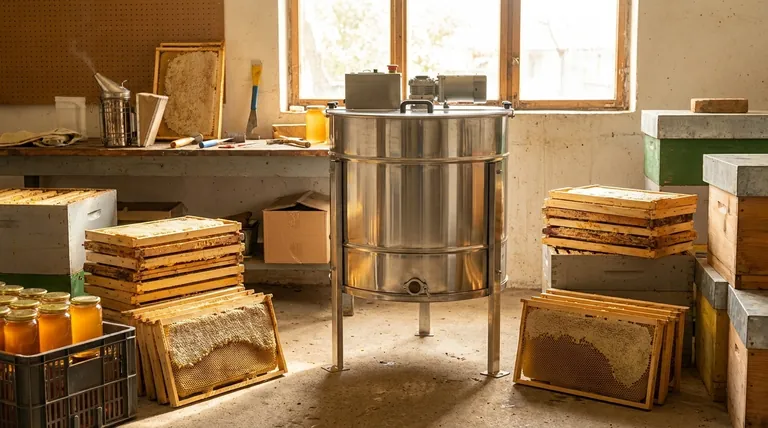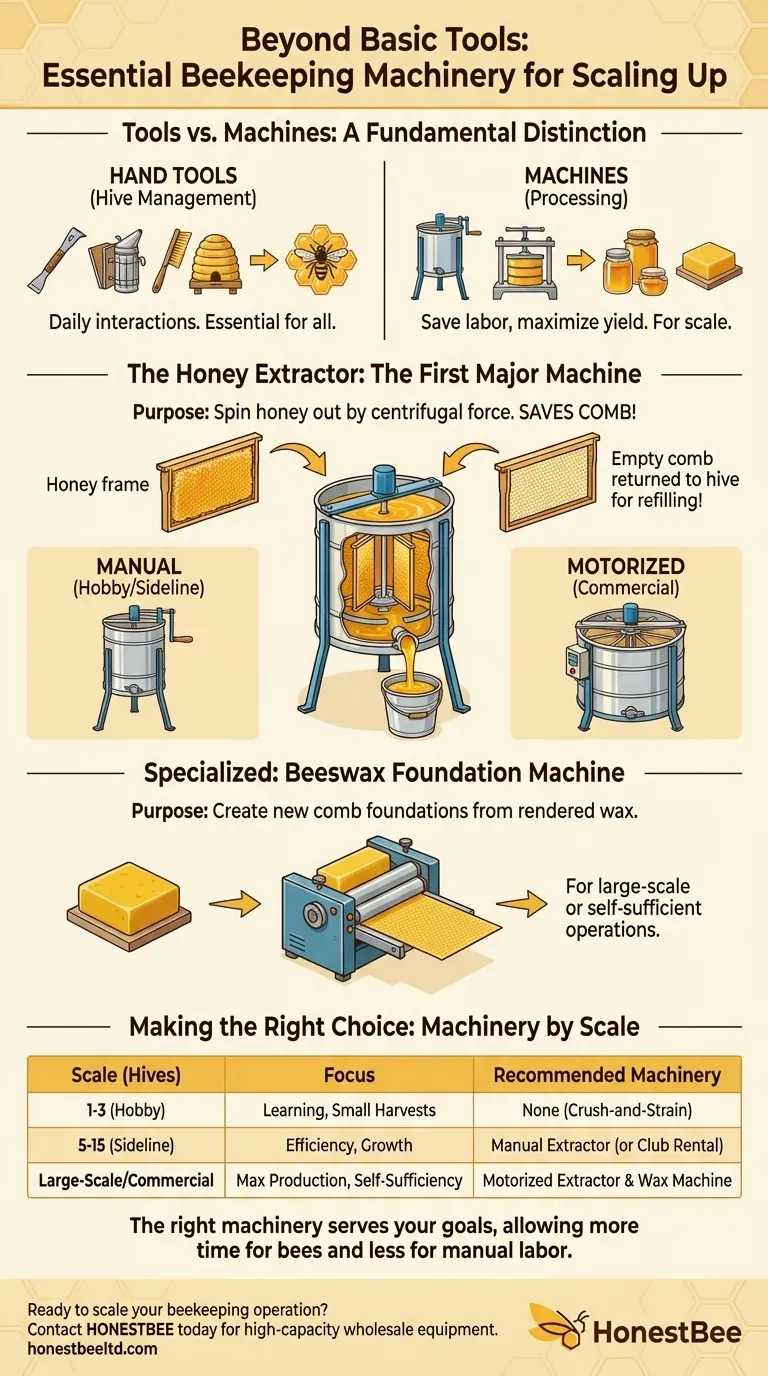Beyond basic handheld tools, the primary machines in beekeeping are used for processing honey and wax, not for managing the hives themselves. The most common machine is a honey extractor for separating honey from the comb, while more specialized equipment includes beeswax foundation machines for creating new comb foundations.
The crucial distinction for a beekeeper is not the quantity of equipment, but its purpose. Hand tools are for interacting with bees and hives, while machines are for efficiently processing the products of the hive—primarily honey and wax—at a scale beyond a small hobby.

Tools vs. Machines: A Fundamental Distinction
Before investing in equipment, it's vital to understand the different roles tools and machines play in your beekeeping operation.
The Realm of Hand Tools
Your daily and weekly interactions with the hives are managed with a core set of hand tools. These are non-negotiable for any beekeeper, regardless of size.
This includes the hive tool for prying frames apart, a smoker to calm the bees, and a bee brush to gently move bees off a frame. These are essential for basic hive inspection and management.
The Role of Processing Machinery
Machines enter the picture after you harvest your honey. Their purpose is to save labor and maximize the yield from your hives.
These are not required for your first hive but become increasingly important as your operation grows and you begin processing larger quantities of honey.
Core Beekeeping Machines Explained
The machinery you need is directly tied to the scale of your operation and what you plan to do with your harvest.
The Honey Extractor: The First Major Machine
The most common machine a growing beekeeper will purchase is a honey extractor. This device uses centrifugal force to spin honey out of the frames without destroying the wax comb.
This is a significant advantage because it allows you to return the empty "drawn" comb to the bees. They can then refill it with honey immediately, saving the immense energy they would have spent rebuilding wax.
Extractors range from small, hand-cranked two-frame models for hobbyists to large, motorized radial units that can process dozens of frames at once for commercial operations.
Wax Processing: The Beeswax Foundation Machine
For beekeepers who want full control over their hive components, a beeswax foundation machine is a more advanced investment. This machine takes rendered beeswax and presses it into the thin, patterned "foundation" sheets that guide bees in building straight comb.
This is specialized equipment. Most beekeepers simply purchase pre-made foundation, making this machine relevant only for large-scale operators or those committed to a completely self-sufficient system.
Understanding the Trade-offs
Investing in machinery is a decision based entirely on scale, time, and return on investment.
Hobbyist vs. Commercial Scale
For a beekeeper with one to three hives, no machines are truly necessary. Honey can be harvested using the "crush and strain" method, where the entire comb is crushed and the honey drains through a filter. This destroys the comb but requires no special equipment.
As you expand to five, ten, or more hives, the labor saved by a honey extractor becomes significant. The time spent crushing and straining dozens of frames makes an extractor a worthwhile investment.
The Cost vs. Time Equation
A small manual extractor represents a notable financial investment. Its value is measured in the hours it saves during the busy harvest season and in the increased efficiency for your bees, who get to reuse the comb.
Before buying, consider your time. If a honey harvest takes you an entire weekend with crush and strain, an extractor that cuts that time down to a few hours may be worth the cost.
The Beekeeping Community Resource
Many local beekeeping associations own a club extractor that members can rent for a small fee. This is the single best way for a new beekeeper to access machinery without the upfront cost, allowing you to experience the benefits firsthand before deciding to buy.
Making the Right Choice for Your Goal
Your equipment needs should be dictated by your beekeeping ambitions.
- If your primary focus is managing 1-3 hives as a hobby: Start with zero machines. Use the simple crush-and-strain method for your first few harvests to understand the process.
- If your primary focus is growing to 5-15 hives (a "sideline" business): Your first machine should be a small, manual honey extractor. Look for a local club to rent one from first.
- If your primary focus is large-scale production or total self-sufficiency: A motorized radial extractor is essential for efficiency, and a beeswax foundation machine may become a logical next step.
Ultimately, the right machinery is the equipment that serves your goals, allowing you to spend more time enjoying your bees and less time on manual labor.
Summary Table:
| Machine | Primary Use | Ideal For |
|---|---|---|
| Honey Extractor | Spins honey from frames without destroying comb | Hobbyists expanding to 5+ hives; all commercial apiaries |
| Beeswax Foundation Machine | Presses wax into sheets to guide comb building | Large-scale operators seeking total self-sufficiency |
Ready to scale your beekeeping operation with the right machinery?
As a leading wholesale supplier to commercial apiaries and distributors, HONESTBEE provides the durable, high-capacity equipment you need to maximize your honey yield and operational efficiency. Our experts can help you select the perfect extractors and other machinery to match your specific scale and goals.
Contact HONESTBEE today for a quote and discover how our beekeeping supplies can power your growth.
Visual Guide

Related Products
- Electric 8 Frame Honey Spinner Extractor Equipment for Beekeeping
- HONESTBEE 3-Frame Manual Acrylic Honey Extractor
- HONESTBEE 72 Frame Industrial Electric Honey Extractor for Beekeeping
- 2 Frame Stainless Steel Manual Honey Spinner Extractor for Beekeeping
- 8-Frame Electric Self-Reversing Honey Extractor Spinner for Commercial Honey Extraction Equipment
People Also Ask
- What are the benefits of using a honey extractor? Maximize Harvest & Save Bee Energy
- What should be considered when harvesting honey from multiple hives? Scale Your Harvest Efficiently
- What are the differences between manual and electric honey extractors? A Beekeeper's Guide to Power, Speed & Cost
- How long should you spin honey? Master the Art of Efficient, Damage-Free Extraction
- How long should you spin honey for? Master the Art of Efficient, Safe Extraction



















